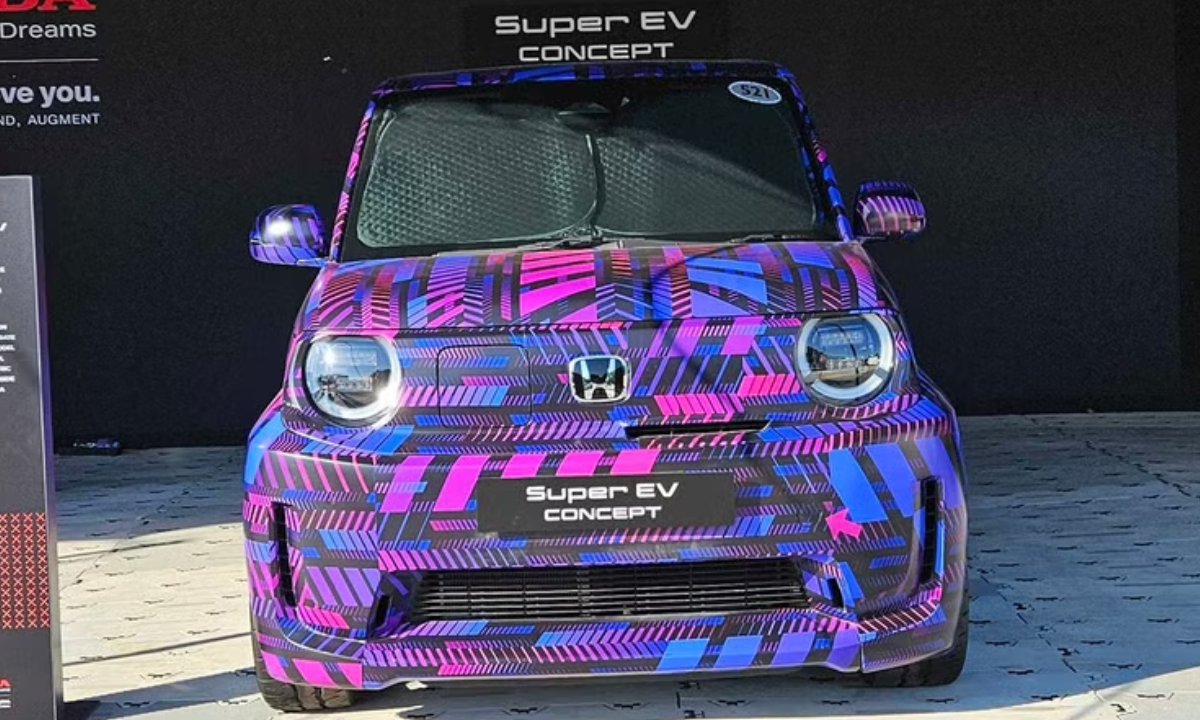The 2025 Goodwood Festival of Speed witnessed an unexpected star stealing the spotlight from supercars and hypercars alike. Honda’s mysterious Super EV concept, wrapped in quirky purple camouflage, made its debut among the legendary hillclimb’s most prestigious automotive displays. This compact electric vehicle represents Honda’s bold vision for affordable urban mobility, potentially filling the void left by the discontinued Honda e.
A Mysterious Urban Electric Marvel
The Super EV concept has already been undergoing real-world testing in the UK, complete with that distinctive purple camouflage that turned heads at Goodwood. Honda describes this creation as an “all-electric urban concept vehicle” that “realizes both practical usability and the ‘joy of driving’ only Honda can offer.”
Standing among generations of Civic Type-R models and the championship-winning 1986 Williams Honda F1 car, this diminutive electric vehicle commanded attention through sheer character rather than raw power. Despite its small footprint, Honda has managed to inject substantial personality into this city-focused design.
Design Philosophy and Visual Appeal
The Super EV’s aesthetic immediately communicates fun and functionality. Even with the camouflage obscuring many details, the car’s boxy arches, door line cuts, and prominent Honda badge create an unmistakably cheerful presence. The vehicle sits on striking 16-inch wheels that emphasize its compact proportions while maintaining an assertive stance.
Honda’s design team has embraced the constraints of urban electric vehicle packaging, creating something that appears both practical and emotionally engaging. The purple camouflage, while serving to conceal production details, has become an integral part of the car’s initial identity, earning it the affectionate nickname “Purple People Pleaser” among enthusiasts.
Technical Specifications and Performance
The Super EV employs a front-wheel-drive configuration with a single electric motor, positioning it as a direct successor to the Honda e. This simplified drivetrain approach aligns with Honda’s goal of creating a more accessible electric vehicle compared to its predecessor.
The vehicle incorporates practical cost-saving measures without compromising functionality. Rear drum brakes handle stopping duties, which Honda justifies as appropriate for a car this size where regenerative braking performs most of the work. This approach mirrors strategies used by premium manufacturers like Audi in their electric vehicle lineup.
Market Positioning and Affordability Strategy
Honda’s approach with the Super EV represents a significant departure from the Honda e’s positioning. The company emphasizes that this new model will be far more affordable than its predecessor, incorporating conventional features like traditional door mirrors rather than expensive camera systems.
The Honda e, while technologically impressive with its pillar-to-pillar screen displays and camera-based mirrors, proved too expensive for mainstream adoption. The Super EV concept addresses these concerns by prioritizing cost-effectiveness while maintaining Honda’s commitment to driving enjoyment.
Competition and Market Context
The Super EV will compete in the A-segment electric vehicle market alongside established players like the Fiat 500e, Renault Twingo, and Volkswagen Up!. This segment typically emphasizes “cheap and cheerful” characteristics, contrasting with Honda’s more upmarket 0 Series models.
Honda’s challenge lies in differentiating the Super EV through its traditional strengths: reliability, practicality, and driving dynamics. The company’s decades-long reputation for creating engaging small cars provides a foundation for success in this competitive segment.
Global Ambitions and Production Timeline
Honda intends to bring the Super EV to market around the world, potentially serving as the perfect replacement for the already-missed Honda e. While Honda remains secretive about specific pricing targets and production timelines, the vehicle’s presence at Goodwood suggests development is progressing toward commercial viability.
The global rollout strategy indicates Honda’s confidence in the Super EV’s broader appeal beyond European markets. This worldwide approach could help achieve the production volumes necessary to maintain competitive pricing.
Industry Implications
The Super EV’s development reflects broader industry trends toward affordable electric mobility. As governments worldwide implement stricter emissions regulations and urban areas restrict combustion engine access, manufacturers must balance environmental requirements with consumer affordability.
Honda’s approach demonstrates that electric vehicles need not sacrifice character for efficiency. The company’s commitment to maintaining driving enjoyment in small electric cars could influence competitor strategies and consumer expectations in the urban EV segment.
Development Philosophy
Honda’s commitment to enjoyable and fun-driving cars, even when they’re tiny and electric, represents a key part of what makes Honda Honda since it first hit the market decades ago. This philosophy differentiates the Super EV from purely utilitarian urban transport solutions.
The vehicle’s design and engineering approach suggest Honda recognizes that successful electric vehicles must offer more than environmental benefits. Emotional connection and driving satisfaction remain crucial factors in consumer adoption, regardless of powertrain type.
FAQs
Q: What makes Honda’s Super EV concept different from the previous Honda e? A: The Super EV focuses on affordability and practicality rather than high-tech features. It uses conventional door mirrors instead of cameras and prioritizes cost-effective components while maintaining Honda’s driving enjoyment philosophy.
Q: What are the key technical specifications of the Super EV? A: The vehicle features front-wheel drive with a single electric motor, 16-inch wheels, and rear drum brakes. It’s designed as a direct successor to the Honda e but with more accessible pricing and simplified technology.
Q: When will the Honda Super EV be available for purchase? A: Honda has not announced specific production timelines or pricing, but the company has stated intentions to bring the vehicle to market globally. The Goodwood appearance suggests development is progressing toward commercial viability.
Q: Why is the Super EV wrapped in purple camouflage? A: The purple camouflage serves to conceal production design details while the vehicle undergoes real-world testing in the UK. The distinctive coloring has become part of the car’s early identity and earned it the nickname “Purple People Pleaser.”
Also read: Tesla Model Y Hits 155,000 Production Milestone: EV Market Leader – Deanoslawnsandproperties
